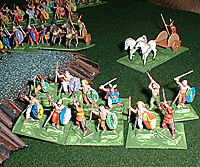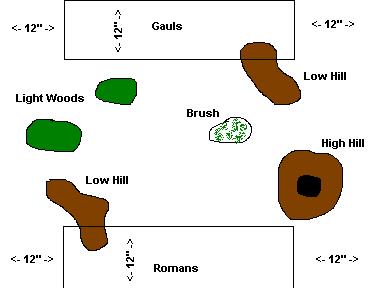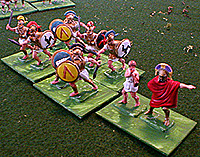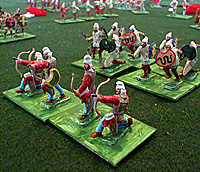 We decided to try out Bob Bryant's Might of Arms rules with some simple scenarios. Two small battles were set up using the army lists in the back of the rules. Units each had 3 or 6
stands. The figures were 1/72 plastic, so we decided to use the 25 mm charts. Both battles evolved quickly and we had a decisive outcome in less than three hours.
We decided to try out Bob Bryant's Might of Arms rules with some simple scenarios. Two small battles were set up using the army lists in the back of the rules. Units each had 3 or 6
stands. The figures were 1/72 plastic, so we decided to use the 25 mm charts. Both battles evolved quickly and we had a decisive outcome in less than three hours.
The rules are designed for battles from ancients to the 1500s. The rules include 150 army lists, eliminating the need to purchase costly supplements. However there are no scenarios in the book, just a few examples of armies purchased for varying amounts of points. But this should be no obstacle for ancient wargamers who are accustomed to fighting "points" battles. The rulebook is full of useful examples, which make it a tough read the first time through. It's best to take the author's advice and just jump right in. A two-sided reference sheet is well designed and includes all the necessary charts and a bunch of handy summaries of the rules. Questions about the rules can be answered discussed on the Might-of-Arms discussion group at Yahoo Groups (http://groups.yahoo.com/group/Might-of-Arms).
The rules covering missile fire and melee are very simple. The rules covering movement and morale are more complicated, and we made several mistakes in our first game. Despite this the game moved quickly. MOA is free of some of the details that bog down other rules that cover this period of history. Units are rated according to type (Heavy Infantry, Knight Infantry, etc.) and have a Class Rating from A - E. There's no need to distinguish particular weapons or armor type. Units can also be classified as elite, and you can strengthen or weaken units by including more or fewer stands.
Melee and shooting result in hits, however casualties are not removed. Instead, when a unit accumulates a number of hits equal to its number of stands it gets a fatigue point. Fatigue points will give the unit negative modifiers when making morale checks.
There are three morale states: normal, shaken and routed. Routed units are removed from the board. Figuring out who has to take a morale check, and in what order, was the most difficult part of the rules. More experience with the rules will make this much easier. In conclusion, we liked the rules. Clever tactics were rewarded, and the units behaved as one would expect. We will certainly try them again.
Battle Report 1:
Romans vs. Gauls
The Romans set up their artillery on the low hill on their left, with their infantry units side by side on the open ground, skirmishers in front. Their cavalry were put on the left flank. The Gauls deployed their war bands in front of the Roman infantry, with their cavalry on their left. As the battle began the Romans advanced. The Gauls quickly moved to their left, with the cavalry turning the Roman flank. The plan was to bring a concentrated attack on the end of the Roman infantry line before the Roman cavalry could arrive.
The Roman artillery punished the Gauls at long range as they moved to their left but soon found their fields of fire blocked by their own infantry, which had advanced too far. A Gallic infantry unit was deployed in the woods to slow the Roman cavalry, which decided to take a wide detour around them. In the center the skirmishers clashed inflicting a few hits before they were routed. Roman skirmishers moved on to the high hill on their right to slow the Gallic flanking maneuver, but they were chased away by cavalry.
The Gauls attacked the end of the Roman line, matching two of their units against one Roman unit. A grinding match began and after some lousy dice rolls the Roman unit was shaken, and then routed. The Romans tried to move to meet the threat on their flank but found it slow going. They were unable to protect their flanks and the Gauls were quick to take advantage. The Roman Cavalry tried to ride to the rescue but found their path blocked by two units of Gallic infantry. They tried to fight their way through but the delay was fatal. The Gauls had out maneuvered the Romans and were able to wear down the Elite infantry with swarm tactics. The battle ended as a decisive Gallic victory.
Order of Battle: Gauls vs. Romans
Gallic Army
- C-in-C
War Band 1
- Commander
1 Sk Ing (slings) Class C
1 Md Inf Class B
3 Md Inf Class C
War Band 2
- Commander
1 Md Inf Class B
3 Md Inf Class C
Cavalry
- Commander
1 Hv Cav Class B
2 Md Cav Class B
Romans
- C-in-C
Cohort 1
- Commander
1 Sk Inf (javelins) Class C
2 Elite Hv Inf Class B
1 Art Bolt Shooter Class C
Cohort 2
- Commander
1 Sk Inf (javelins) Class C
2 Elite Hv Inf Class C
1 Art Bolt Shooter Class C
Cavalry
- Commander
3 Hv Cav Class B

Battle 2:
Greeks vs. Persians
 This battle was fought on a flat, featureless plain. The Persians set up with the Immortals on the left flank. In the center the skirmishers and medium infantry led the way. The Greeks advanced quickly to minimize their losses from the skirmishers. The Persian right flank moved to envelope the Greeks, but that move was countered. All along the line the Greeks engaged the Persians. In several places the Greeks were able to take on the Persians at a 2:1 advantage. The Persian front line began to buckle. The Immortals slammed into the right side of the Greek line and were met by the Greek Class B heavy infantry. A grinding match began.
This battle was fought on a flat, featureless plain. The Persians set up with the Immortals on the left flank. In the center the skirmishers and medium infantry led the way. The Greeks advanced quickly to minimize their losses from the skirmishers. The Persian right flank moved to envelope the Greeks, but that move was countered. All along the line the Greeks engaged the Persians. In several places the Greeks were able to take on the Persians at a 2:1 advantage. The Persian front line began to buckle. The Immortals slammed into the right side of the Greek line and were met by the Greek Class B heavy infantry. A grinding match began.
Persian units began to run, and for a while the army wavered. But the reserves shook off their doubts and marched into the meat grinder. Again the Greeks were able to chew up the Persians. Finally the Immortals were able to rout their opponents. They turned to their right, to roll up the Greek line.
 By now the surviving Greek units were in bad shape, smothered in fatigue markers.
The surviving Persian skirmishers poured arrows into them. The Greeks couldn't make the morale check needed to charge out the skirmishers so they had to stand and take it, while the Immortals rumbled towards them. Soon it became clear that the Greeks wouldn't be able to stop the Immortals, and the game was called a narrow Persian victory.
By now the surviving Greek units were in bad shape, smothered in fatigue markers.
The surviving Persian skirmishers poured arrows into them. The Greeks couldn't make the morale check needed to charge out the skirmishers so they had to stand and take it, while the Immortals rumbled towards them. Soon it became clear that the Greeks wouldn't be able to stop the Immortals, and the game was called a narrow Persian victory.
Order of Battle: Greeks vs. Persians
Persian Army
- C-in-C
Command 1
- Commander
2 Immortals, HI (bow), A
1 MI (bow), C
3 SkI (bow), D
2 SkI (jav), D
Command 2
- Commander
2 HI (bow), C
2 MI (bow), C
2 SkI (bow), D
3 SkI (jav), D
Command 3
- Commander
2 HI (bow) C
1 MI (bow), C
3 SkI (bow), D
2 SkI (jav), D
Greek Army
- C-in-C
Command A
- Commander
3 HI, B
1 HI, C
1 SkI (bow), C
1 SkI (jav), C
Command B
- Commander
1 HI, B
2 HI, C
1 SkI (bow), C
Command C
- Commander
1 HI, B
2 HI, C
1 SkI (sling), C
Back to SJCW The Volunteer Fall 2001 Table of Contents
Back to SJCW The Volunteer List of Issues
Back to Master Magazine List
© Copyright 2001 by SJCW
This article appears in MagWeb (Magazine Web) on the Internet World Wide Web.
Other military history articles and gaming articles are available at http://www.magweb.com